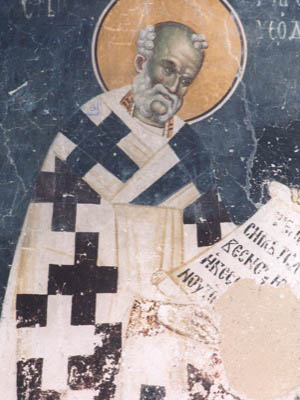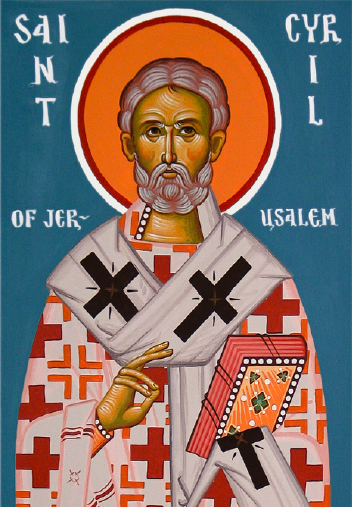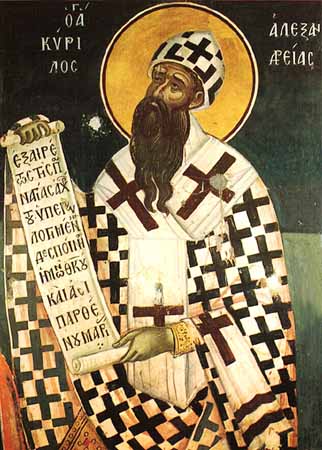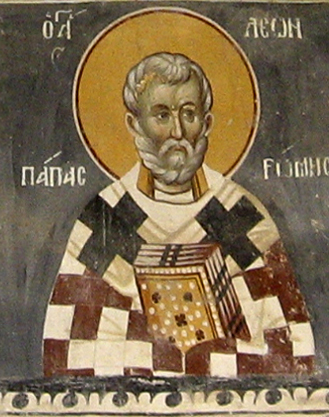
(version of 04JUN13)
Here follows a series of introductions and links to selected catechism-related materials of use both to those preparing for Holy Baptism in the Orthodox Church, and for those wanting to refresh or enhance their learning of these basic doctrines.

Fresco of St. Gregory the Wonderworker (provenance unknown).
After St. Gregory was consecrated, he kept vigil for many days "and entreated the Master Christ to reveal to him clearly the mystery of piety, lest he should err and fall into some heresy. ... Thus, he kept constant in prayer and was vouchsafed a vision of a sacred, graceful, and distinguished elder. Bishop Gregory... asked, 'Who art thou, and why hast thou come?' The holy elder responded, 'The Lord sent me to thee to dissolve every doubt and to reveal to thee the exact pious Faith.' Hearing the elders words, Gregory was filled with joy. He then beheld nearby an exceedingly radiant woman, from whom shown forth a surpassingly brilliant light, though it was in the deep of night. She spoke to the elder and said, 'John, genuine friend of my son and God, reveal to this young man the mystery of the truth.' The evangelist, obeying the command of the most holy Theotokos, wrote the teaching concerning the mystery of the Holy Trinity, and he gave it to Gregory, speaking these things: 'There is one God, the Father of the Living Logos, His hypostatic Wisdom and Power and eternal Impress [Heb. 1:3]: Perfect Begetter of the Perfect, Father of the only-begotten Son. There is one Lord, One only of One only, God of God, Impress and Image of the Divinity, energizing Logos, Wisdom and embracing and comprehending all that has been ordered and set together, and creative Power of the entire creation, true Son of true Father, Invisible of the Invisible, and Incorruptible of Incorruptible, and Deathless of Deathless, and Eternal of Enternal. There is one Holy Spirit, having being of God and made manifest, that is to say, to men, through the Son, perfect Image of the perfect Son. Cause of life of all living, holy Fount, Sanctity providing sanctification, in Whom God the Father reveals Himself, the One Who is over all and in all [Eph. 1:6], and God the Son, by means of Whom are all things [Heb. 2:10]; perfect Trinity, in glory, and eternity, and sovereignty, neither divided nor estranged.'" (The Great Synaxaristes of the Orthodox Church, November, Holy Apostles Convent, Buena Vista, CO, 2002, pp. 721-722; volume available here.) The revelation given Saint Gregory by St. John is referred to in the Synaxaristes as the Ekthesis of the Faith, and which provides a Trinitarian exposition of belief. In the available English translation, The Works of Gregory Thaumaturgus, Dionysius of Alexandria, and Archelaus, Ante-Nicene Christian Library: Translations of the Writings of the Fathers down to A.D. 325, Vol. XX, Clark, Edinburgh, 1871, p. 81 ff, it is referred to as the "Sectional Confession of Faith"; this volume is available here in various formats. The material from this volume is also available in expanded, later editions, such as here in pdf, or here in several formats (identified as vol. VI of the ANF series). A local pdf copy of the 1871 edition of the "Sectional Confession of Faith" extracted from the larger volume is available locally here, and in html format here. The reader of this material should beware of Protestant skepticism that may have crept into the translation (e.g., in statements such as "dubious or spurious writings" and in possible errors due to "theological" biases).

Detail from Icon of St. Cyril of Jerusalem (iconographer: Archbishop Gregory; copy available for order here).
In the dignity of Patriarch of Jerusalem, Saint Cyril zealously fought against the heresies of Arius and Macedonias. Of the works of Saint Cyril, particularly well known are 23 lectures that are based on providing a detailed explanation of the Symbol of Faith. The saint suggests that the Christian should inscribe the Symbol of Faith upon the tablets of the heart for they were not compiled through human cleverness, for— just as a tiny mustard seed has contained within it all that is necessary to produce a tree (cf. Matthew 13:31–32, Mark 4:30–32, and Luke 13:18–19)—therein is gathered everything most important from all the entire Scripture as a single teaching of Faith. The original English translation was published as The Catechetical Lectures of S. Cyril, Archbishop of Jerusalem, A Library of Fathers of the Holy Catholic Church, Anterior to the Divison of the East and West, Vol. II, Oxford, John Henry Parker; J.G.F. and J. Rivington, London. 1838; this volume is available here in various formats. The material from this volume is also available in later editions, such as here or here in several formats (identified as vol. VII of the NPNF second series). The material is also available in html format here. A local copy of the 1838 text without the front or back matter is available in pdf format here. The reader of this material should beware of Protestant skepticism that may have crept into the translation.
The following materials from St. Cyril of Alexandria and St. Leo the Great that are offered for study differ from others presented here in that they have come down to us with the sanction of one or more Œcumenical Councils. Included here are two Letters to Nestorius by St. Cyril (Nestorianism is a heresy that denies the nature of Christ, as well as the Virgin Mary as Theotokos)--Epistles to Nestorius II and III--both of which were read and approved at the Council of Ephesus, the first was read and acclaimed at the Council of Chalcedon, and both were read and recited as Authority at the Fifth Œcumenical Council that was held in Constantinople. A third letter of St. Cyril's--one to John of Antioch--was also read and acclaimed at the Council of Chalcedon, as was the Tome of St. Leo; both are also referenced here below.

Fresco of St. Cyril of Alexandria (provenance unknown).
St. Cyril was the Patriarch of Alexandria from 412 to 444. He wrote extensively and was incessant in his labors for the Orthodox faith, and zealous in its defense against heresies, such as Novatianism and Nestorianism, as well as Jews and pagans. His epistles that were adopted by Œcumenical Councils is available in The three epistles of S. Cyril, Archbishop of Alexandria, with revised text and English translation, P.E. Pusey, ed., James Parker and Co., London, 1872, which is available here. A local pdf copy of the English translation extracted from this volume is available locally here. Cf. The Oecumenical documents of the faith : The Creed of Nicaea, Three Epistles of Cyril, The Tome of Leo, The Chalcedonian Definition, T. Herbert Bindley, ed., Methuen & Co., London, 1899, available here. The reader of this material should beware of Protestant skepticism that may have crept into the translation.

St. Leo the Great (Church of St. George, Staro Nagoričane, Macedonia).
St. Leo (Leo I or Leo "the Great) was bishop (pope) of Rome from 440 to his death, November 10, 461. Leo had uncompromising firmness in the confession of the Faith, and was one of the basic defenders of Orthodoxy against the heresies of Eutyches and Dioscorus of Alexandria, who taught that there was only one nature in the Lord Jesus Christ. He was also a defender against the heresy of Nestorius. The "Tome of St. Leo" (aka Epistle 28) that was read at the Council of Chalcedon is available in St. Leo's Epistle to Flavian: The Tome of St. Leo, Charles Heurtley, trans., Parker and Co., London, 1885, that is available here. A local pdf copy Tome itself extracted from this volume is available locally here. The reader of this material should beware of Protestant skepticism that may have crept into the translation.
Icon of St. John of Damascus (provenance unknown). |
Icon of the Most Holy Theotokos "of the Three Hands". |
Our holy Father John was born and raised in the city of Damascus, which was, in those days, the capital of the Moslem world. John's learning and ability were such that he was appointed first counselor of the caliph at an early age (some time prior to 705). During the time of John's service to Caliph Al-Walid, the Christ-hater Emperor Leo of Isauria reigned over the Byzantine empire (717-741), and who was an iconomach, and a persecuter of all those that venerated the Holy Icons. The fervent zealot of the Faith, John, spoke out against those who insult or struggle against the Holy Icons (cf. his three "Apologetic Treatises against those Decrying the Holy Images"), and just as strongly against the Islamic religion (cf. his "Disputation Between a Saracen and a Christian"). While John's epistles served to strengthen the Faithful, they incited the impious Leo to seek to bring harm to John; unable to directly attack him, Leo had documents forged and sent to the Caliph that portrayed John as traitor. As a result of Leo's treachery, the Caliph had John's right hand cut off and hung in the market place that all may see it. That night John requested of the Caliph his hand back that he might bury it, and so it was returned. John then took up his severed hand, went into the church he had in his house, placed it upon the icon of the Mother of God, and fell face down on the floor before it, praying fervently with faith and tears for healing; overcome by sleep, he had a vision of the Ever-virgin who spoke with him: "Behold, thy hand is now whole; ... from now on become the pen of a swiftly writing scribe... ." John then awoke and beheld the miracle—his right hand was attached and healed; only a mark, like a thin red thread, encircled the wrist where it had been severed for evidence against false accusers. As a token of his thankfulness for this healing, John placed on the icon a hand fashioned of silver, from which it became known as the Icon of the Mother of God named "of Three Hands;" for some time—centuries—this Icon has been located in the Kilendaria monastery on Mt. Athos. (The information concerning St. John's life was extracted from The Great Synaxaristes of the Orthodox Church, December, Holy Apostles Convent, Buena Vista, CO, 2004, pp. 188-203; volume available here.) And, as we might guess, St. John was "a swiftly writing scribe" for the rest of his life, with his works including homilies, theological works, music theory, and liturgical poetical works (e.g., canons, troparia, idiomela, and prosomia; in fact, the major portion of the Octoechos and Parakletike is the work of St. John). Of particular interest here is what some consider to be his greatest work: the Fount of Knowledge composed in three parts, "Philosophical Chapters," "Heresies in Epitome" and "An Exact Exposition of the Orthodox Faith." It is the "Exposition" that provided the Orthodox Church with a catechism that served without the need for additions for almost a thousand years! Not until the late 16th and 17th centuries when the heresies of the Western church were causing major disruption across Eastern Europe—from the attacks of the Swedes and their Latinism and Lutheranism in the North, to the Polish-Lithuanian Commonwealth and the Latins with their Jesuit "army" who ruled over "White Russia" (Belorussia) and most of "Little Russia" (Ukraine), to the Hapsburg Empire pushing Latinism and Calvinism in the northern Balkans, Slovakia, Bulgaria, and Romania—did the Church recognize the need to supplement St. John's cathecism with additional statements regarding the True Faith. In terms of English translations of "An Exact Exposition of the Orthodox Faith,"there are at least the following two choices: one by a Rev. Salmond (Protestant) in 1898 that appears as one of the articles in A Select Library of Nicene and Post-Nicene Fathers of the Christian Church, Second Series, Vol. IX, Charles Scribner's Sons, New York, 1908 (available here or here, or in html here); and one by Frederic H. Chase, Jr. (Roman Catholic) that appears as a section in Saint John of Damascus: Writings, The Fathers of the Church: A New Translation, Vol. 37, Fathers of the Church, Inc., New York, 1958 (available here or the section extracted here). A local copy of the 1898 version of Exact Exposition extracted from the 1908 NPNF 2-9 is available here. The reader of this material should beware of Western skepticism that may have crept into the translations.
Some additional catechisms of interest from the 17th, 18th, and 19th centuries:
V. Most Rev. Peter (Mogila), Metropolitan of Kiev and Galicia [+1646]
The Orthodox Confession of the Catholic and Apostolic Eastern Church, English translation printed in 1762. About 200 pages in Q&A style. (Alternate translation here.) [Endorsed by the Patriarch of Constantinople and 25 members of his "sacred Congregation of Archbishops, and Clergy," in 1643, and the Patriarch of Jerusalem in 1662.]
V. Most Rev. Platon (Levshin), Metropolitan of Moscow [+1812]
The Orthodox Doctrine of the Apostolic Eastern Church, English translation (of the Greek translation of the Russian!) printed in 1857. About 200 pages in prose. A different translation is available as "Orthodox Doctrine; or, A Summary of Christian Divinity" in The Present State of the Greek Church in Russia, English translation of the "Slavonian" printed in 1814.
Platon's work ABRIDGED:
The Great Catechism of the Holy Catholic, Apostolic, and Orthodox Church, English translation (of the Greek translation of the Russian!) printed in 1867. (Also available here.) About 50 pages in prose. [The Greek version having been printed under the auspices of the Holy Synod of Greece in 1851 and 1857, and under the approbation of the Patriarch of Antioch.]
Then, in a single volume entitled entitled The Doctrine of the Russian Church, being the Primer or Spelling Book, the Shorter and Longer Catechisms, and a Treatise on the Duty of Parish Priests (Blackmore, R.W., trans., Joseph Masters, London, 1845), among other things, the following three works are found:
Most Rev. Feofan (Prokopovich), Archbishop of Pskov [+1736]
Archbishop Feofan is credited with drafting The Russian Catechism. In this translation (The Doctrine...) his work (apparently) appears as: "A Brief Catechism"—about 7 pages in Q&A style. [Another, different work also identified as Archbishop Feofan's Russian Catechism in online library catalogues, but attributed to an Archbishop Resenski in the translator's "advertisement", was published in an English translation (of the German translation of the Russian!) in 1723, which sets out to explain the Ten Commandments, the Lord's Prayer, and the Symbol of Faith—and runs about 30 pages, partially in Q&A style.]
V. Most Rev. Philaret (Drozdov), Metropolitan of Moscow [+1867]
"A Short Catechism". About 11 pages in Q&A style.
"The Longer Catechism of the Orthodox, Catholic, Eastern Church". About 80 pages in Q&A style.
Dēmētrios Nikolaou Bernardakēs [+1907]
A Catechism (Approved and Adopted for Use in the Primary Schools of the Great Church of Christ), Cobham, trans., Cyprus, 1903. About 30 pages in Q&A style. [Approved by the Patriarch and Synod of Constantinople.]